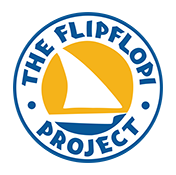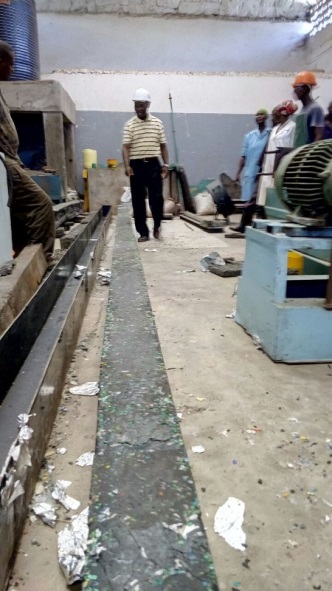How to turn Kenyan beach plastic into a boat – in 15 pictures
Written by Ben Morison
How we are turning Kenyan beach plastic into an expedition vessel ready to sail to Cape town
The Dhow is our communications platform. Yes we are going to campaign against single-use plastics, but those 5 words ‘campaign against single-use plastics’ have probably sent you to sleep already.
It might be clever and pioneering, but it will only communicate this, if it is eyecatching. And to do so we’re using the simplest tool ever. We’re making it fun. Simply that, nothing more. Just language-crossing, culture-crossing, continent-crossing FUN in all its universality. That is how we communicate.
So anyway, getting on with it… We are building a boat this big (see below). This is a wooden Dhow at our workshop that we are using as a template, by recycling lots of plastic that friends and supporters are collecting from the beaches.
If the above picture is a Dhow… then the image below left is ‘The FlipFlopi Dhow’. Yes, this scale model is an accurate representation of the pioneering expedition vessel that will sail from Lamu to Cape Town in 12 months time.
So now you see it… Fun… and communicative in a very simple way. Its obviously going to get attention… (actually its already doing so despite being just an idea, not a thing) but even so, we’re not leaving it to chance – we are backing this up with a professionally run PR campaign to ensure global broadcast, print and online coverage.
Aside from the visual impact, its also interesting. It is made from this plastic from a beach in Lamu.
Yes, this actual plastic you can see in this picture, (not some other plastic that looks like this)… Of course we picked it up after these pictures were taken and put it into these bags you can see below.
By the way, all these bags filled with plastic waste weighed 5 tonnes! 50 of us collected this in just 3 hours on a 5 km stretch of beach in Sept 2016.
From here they went to a recycling business in Malindi.
It ends up in a big pile ready to be recycle. Just think, if this plastic was not here, it would be in the sea, on the beach or inside the stomach of birds and fish.
Meanwhile – we have worked with our Dhow builders and local metal workers to make simple steel moulds in the shapes of big parts of the Dhow (the bits that traditionally are made from giant bits of hardwood that are no longer found anywhere near the coast).
Which is then put onto an extruder that fills it with melted down plastic waste.
…..and you end up with this!
We used the same process to make the planks, poles and tiles needed to make our dhow. For example, have a look at this huge 10 metre piece that will end up being half of the FlipFlopi keel. It weighs 700 kilos and took 2 whole days to cure (to cool down & harden).
The only issue we have with the above materials is that – pioneering though they are – they don’t look that exciting.
We realised we had to do something about this – otherwise people wouldn’t give our revolutionary plastic boat the attention it deserves. And without the attention, we’d have no campaign platform.
This is where the flip-flops come in.
So meanwhile, working with local community groups, we’ve been collecting flip-flops (which on our Lamu beach clean up in September – were the biggest component of the plastic waste by a mile!!) If you have a close look at the pic below and you’ll see what I mean. There’s more than you think… I can count 23.
Here on the right are some sacks from the beach cleanup too. Zoom in on the top of them, all full of flip-flops.
And this is just a fraction of our flipflop haul from that day. We also looked for the brand names on all these flip-flops,
- Where discernible - I found many were local Kenyan and Tanzanian brands,
- but just as many were clearly brands from Asian subcontinent... bourne across the Indian Ocean on the South Equatorial current that flows directly from S E Asia unhindered until it reaches the coast of East Africa.
We have flip-flops being collected in Mombasa, Watamu, Malindi and Lamu. They are cleaned up, and then glued together to make 1m sq panels. We then buy them from the community groups – looking like this;
All we now need to do is glue our colourful flip-flop panels to the side of our plastic dhow (BTW we still need to work out how to do this – so email us your ideas) and it becomes The FlipFlopi!! And now we can be sure that people will LOOK!
A fun repository for serious message –
- that we have to stop using single-use plastics like we are.
- that plastic is a remarkably durable and useful material… even plastic that’s already been used – we even built this boat from it.
So that’s basically how this all works… but I mustn’t finish without mentioning the key final ingredient!
…. which is these guys below
Between them they have around 200 years of experience building dhows. The head fundi (boat builder) is called Ali Skanda (holding the flip-flop panel).
And these guys are important. They aren’t just a means to the end objective. They’re also part of the objective. Dhows, and the craftsmanship involved in building them, are a central element to Swahili culture… the culture of the peoples occupying much of the East African coast – and which finds its best expression in the island of Lamu (the reason Lamu is a UNESCO world heritage site).
Big dhows aren’t made in Lamu anymore… or really anywhere on the Kenya coast now – due in large part to the lack of big enough trees (they’ve all been cut down.. the trees used to make the dhow in the first images on this document came from south sudan… over a 1000kms away).
We hope that publicity from the project + our method of moulding plastic into these big pieces will help Lamu’s dhow building tradition - and in turn swahili culture - to endure & prosper.




















